Engineering Freshman Women Get Familiar With Campus, Learn About Illinois Resources, and Build Community at WIE Orientation
September 25, 2017

CS freshmen Mackenzie Kirkham and Soumya Kuruvila enjoy the Kahoot game.
The “WIE by the Numbers” slide presented during the introductory session of WIE (Women in Engineering) Orientation, from August 22–24, 2017, says it all. Since its inception 15 years ago, 2,724 female freshman engineering students have participated in Orientation, with 268 students from the fall 2017 freshman class attending. Another impressive number? The 268 women attending Orientation were a just bit more than half of the total number of female engineering students in the fall 2017 clas. This represents the largest number (496) and percentage (25%) of women ever in a freshman engineering class at Illinois—a milestone for Women in Engineering and a cause for celebration. And celebrate they did, as they arrived on campus a few days ahead of all-campus-move-in day, eager to get a head start—to get familiar with campus, make friends and build a community, and to receive sage advice from some older and wiser women in engineering.
Two older and wiser women engineers who shared from their wealth of knowledge and experiences were recent ECE (Electrical and Computer Engineering) graduates, Paula-Angela Mariano and Molly Pace, keynote speakers for WIE Orientation. Both work at Texas Instruments (TI), one of the corporate sponsors who, along with Abbot, sponsored Orientation for the second year in a row.
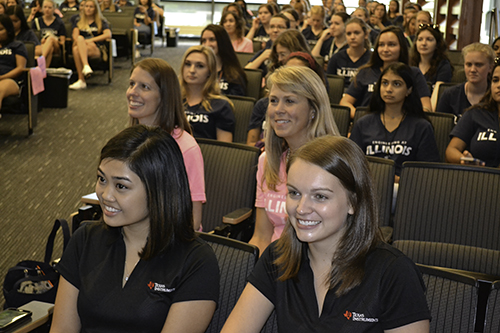
Left to right: Keynote speakers Paula-Angela Mariano and Molly Pace (front row) and WIE Orientation leaders Brooke Newell and Angie Wolters (second row) enjoying the introductory session of WIE Orientation.
Mariano and Pace shared not only about their triumphs, but their somewhat rocky beginnings at Illinois; they recommended resources that helped them overcome challenges they encountered; and they passed on advice about how to not just survive but to thrive during college. Their main goal? To encourage their younger sisters that they, too, would someday be proud Illinois graduates. The two also taught a workshop related to internships with TI.
The WIE Orientation planning committee included Angie Wolters, Director of Women in Engineering; Brooke Newell, WIE Program Coordinator and Academic Advisor; Co-Student Coordinators Siobhan Fox and Elizabeth Sanders; and WIE Administrative Assistant, Amy Cain. The team not only kept Orientation running smoothly, but during the introductory session, they shared the agenda and introduced the various speakers, but they also gave some advice to the freshmen.

Assistant Dean Sue Larson presents her mock lecture to the girls.
To get the girls more engaged, so they weren’t just sitting there listening to people talk to them the entire time, the student coordinators led the freshmen in an ice breaker. For the Trivial-Pursuit-esque game, the girls signed in to Kahoot, a free, game-based learning platform, responding via their cellphones to ten multiple choice questions about Illinois and WIE, such as, “What year did we start?” and “What is the name of our statue on campus?” Kahoot would then immediately show the response rates so they could see how well they had done compared to the other girls.
“They're actually engaging with us in a way that they would in their classes,” Sanders explains.
Also on hand to welcome the freshmen was Dean Sue Larson, who also gave a mock lecture to give the girls a taste of what a college lecture might be like, then led the girls in a hands-on activity about weaving that emphasized listening to instructions, collaboration, and creativity. To her surprise, Larson was also awarded the WIE Champion Award for her years of support to Women in Engineering, including starting the WIE Orientation 15 years ago.
The top five things WIE Orientation planners hoped the girls would take away from Orientation, in descending order, were:
5. Learn about extracurricular activities to join.
Throughout the entire event, presenters recommended that students get involved in extracurricular activities. For instance, during the introductory session, one slide showed nine engineering women’s RSOs (Registered Student Organizations), and keynote speaker Mariano shared how significant one of them, Women in ECE, had been in providing support she needed during her years at Illinois. One workshop on the final day, “Getting Involved in RSO’s,” explained the academic, social, and professional benefits of participating in RSOs, while another, “Greek Life,” touted the benefits of joining a sorority.

A team of girls do a teamwork and communication activity in Civil Engineering's Crane Bay during an event at the WIE Olympics.
4. Get familiar with campus and gather tips from upperclassmen.
Get familiar with campus. In previous years, a scavenger hunt had helped freshmen become familiar with campus. However, this year, the committee implemented the new-and-improved WIE Olympics. Comprised of team-building activities, the different stations took place in departmental buildings and other key locations around campus. For instance, one activity was in the crane bay of Civil Engineering’s Newmark Lab, so freshmen could experience a giant lab. The Electrical and Computer Engineering Building (ECEB) was the location of the Introductory Session, plus other activities; girls hiked to Loomis Lab, the home of Physics, because most freshmen will take an introductory-level physics course there. In addition, various activities were held in other key locations (the Engineering Building, the Materials Science Building, Illini Union, Grainger Library, etc.). Plus, while competing, the girls were awarded points based on how quickly they finished or how well it was done. The team with the most points received an award.

A team of girls prepare to launch a glider they built during a WIE Olympics event at the CCE Building.
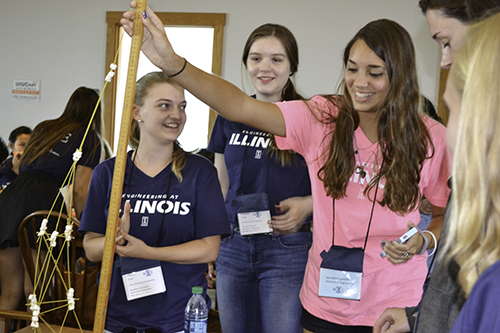
Mentor Jennifer Luebbers (in pink) measures the tower a team built during a WIE Olympics teamwork event at Grainger Library.
However, the Olympics had another emphasis: it underscored five facets of leadership—adaptability, ambition, communication, entrepreneurial spirit, and leverage—to be highlighted in WIE Lead, a leadership lecture series during the upcoming academic year.
For instance, emphasizing adaptability and communication was the “Toxic Waste” event at the Illini Union. Each team received several balls in a bucket, which had been placed in their “toxic waste pile” (a string of yarn on the floor designated the area they weren’t supposed to step into). As a team, they used eight ropes attached to their bucket, to lift and move it out of the waste pile, then dump the balls into a different bucket a couple of meters away. To foster adaptability and communication skills, once they’d begun, their proctor blindfolded one girl. To prevent her from stepping into their waste pile, they had to communicate, telling her, “You can’t step forward; you have to step to your right!” to. (Whoever stepped into the toxic waste wasn’t allowed to use th offending part of her body; if it was a foot, she had to hop on her other foot. If it was her hand, she could only hold the string with her other hand.) “So girls the entire time just have to learn how to communicate and how to adapt to unforeseeable circumstances,” explains Siobhan Fox.
To expose the girls to other campus venues, the freshmen visited Noyes Lab, where most would probably be taking introductory-level chemistry, to experience the ever-popular Chemistry Demo, with its explosions, loud noises, and even a glowing pickle. Along with all the stunts they pulled,, Don DeCoste and Gretchen Adams also imparted some practical tips, like go to classes, don’t be afraid to approach your professor, and don’t neglect the essentials, like sleeping and eating.
Also, instead of friendship bracelet making and movies in Engineering Hall’s basement like last year, the girls were introduced to the Illini Grove, where they roasted marshmallows, and played sports.
Tips from upperclassmen. The notion of older and wiser students giving advice and mentoring the freshmen was built into the fabric of practically every event and group formed during Orientation. Beginning with dinner the first night and over the remainder of the event, upperclassmen both formally and informally shared, not only about academics, but practical tips on how to navigate the college scene. From meals shared with mentors in their departments, to the introductory session on Wednesday morning, to the WIE Olympics, and throughout the numerous workshops on day three, such as “All Things Google,” “Awesome Apps,” “Campus Bus System,” and “Study Smart,” older engineering students showed the newbies “the ropes.”
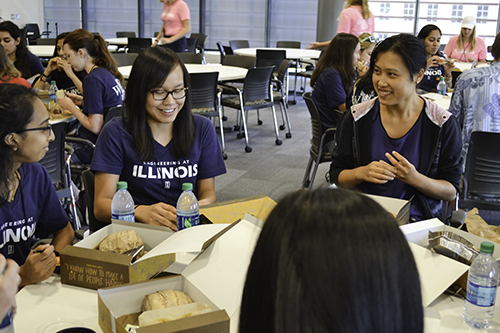
An ECE graduate student (right) gets to know ECE freshmen during Wednesday's departmental luncheon.
3. Meet professors, faculty, mentors, and classmates in their departments.
To encourage freshmen to get acquainted with others in their departments, students were organized by majors for several meals, such as dinner the first night, and breakfast on day two, both held in the Illini Union basement. At the beginning of the orientation, students were grouped by their major, and the mentors were in their major. Plus, departmental luncheons on Wednesday encouraged students to not only meet other freshmen and older students in their departments, but administration, faculty, and other key staff.
2. Discover academic and non-academic resources available on campus.
Academic resources incoming students were introduced to included key people; in fact, two helped run the event—WIE Program Coordinator and Academic Advisor, Brooke Newell, and Angie Wolters, Director of Women in Engineering—who both encouraged freshmen to come see them early and often. In addition, during the workshops, both Larson and Wolters were available for advising sessions.
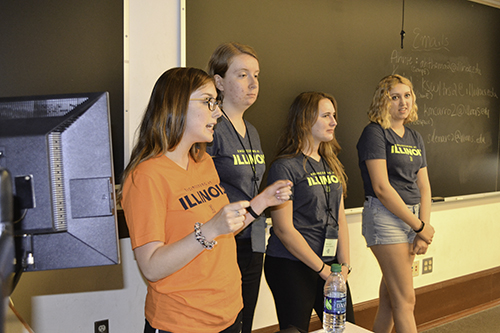
Four engineering upperclassmen share with the freshmen about Engineering Career Fair during a workshop the final day of Orientation.
Numerous other folks advised students to take advantage of other academic resources, including keynote speakers Mariano and Pace, who encouraged students to take advantage of professors’ and TA’s office hours and CARE (the Center for Academic Resources in Engineering) on the 4th floor of Grainger Library. Nonacademic resources mentioned included “Study Abroad,” a workshop presented by IPENG (International Programs in Engineering) representatives; two workshops, “Career Fair Success,” and “Why Freshmen Should Attend Recruiting Events” by Caterpillar’s Mark Niemeyer, underscored that recruiting events are a great resource. “Getting Involved in RSO’s” explained the academic, social, and professional benefits of RSOs.
1. Build a community and make Illinois your home!
The #1 piece of advice students received was this: start building a community! To help students begin, girls were grouped by dorms, which could lead to relationships/study groups with students in their dorms; by department (see #3 above); and this year planners added a third layer: they took students’ schedules into account when forming groups. According to Wolters, Olympic teams were formed based on similarities in their class schedules so they would “get to know each other, and this might help facilitate further community building.”

Dean Sue Larson (center) gets to know a couple of freshmen at breakfast the first full day of camp.
While Siobhan Fox acknowledges that this was “a little bit difficult,” she reports that in previous years, students hadn’t had the opportunity to meet girls in different majors. “So this gives them the opportunity to…meet people that might be in their classes,” she says, explaining that one down side of grouping by majors is that girls in the same major often might not have classes together until their junior or senior year, based on the strength of courses previously taken. “So to help them build their network on campus,” she explains, “we've mixed up the mentor groups.”
In a kind of “afterglow” event, although Orientation officially ended at 1:15 pm on Thursday, mentors led some optional, informal afternoon activities, such as showing girls where their classes would be, so on the first day of classes, they wouldn’t be “scrambling around,” Fox explains. Some mentors took girls to the bookstore so they could give them advice when purchasing textbooks. Others took girls shopping for dorm room stuff or emergency items. Some mentors introduced girls to the bus system so they could learn firsthand how the buses work, which can be intimidating.
The idea behind these informal excursions was to “give girls the opportunity to choose the group that they were with. Maybe they had met someone that they had never had a mentor group with, or maybe they found an upperclassman that they really connected with, and this is their opportunity to continue that friendship,” Sanders explains.
Meet Some Freshmen
Making friends and building community also seemed to be uppermost in the minds of several of the freshmen, who share why they came to WIE orientation.
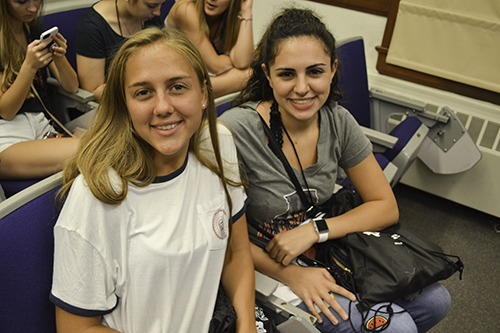
Illinois freshmen Abby Pucek and Haneen Said during one of the Orientation activities.
Abby Pucek, a freshman in Mechanical Engineering, felt WIE orientation was “a good way to get to know the campus a little bit more, and I thought I would meet a lot of friends here before I went to my classes.” Her goal? To find someone she could sit with on the first day of school. And thanks to the new strategy of grouping the girls with others in the same classes, she met someone in the same Calc class: “So we'll probably study together and stuff,” says Pucek.
Pucek’s friend, Haneen Said, an ECE freshman, reports that the most important thing she had gained (as of Wednesday morning) was “Getting to know everyone.” She adds, “Everyone here is new, and everyone here is trying to find their way on campus and trying to use all their opportunities and take advantage of everything. So I think it was cool just to see the different personalities and connect with people. That's what I took more from this, the connections.”
Haneen came to Orientation “for the same reasons practically. I knew that I wanted to make friends, and I didn't know that many people in engineering, from my school at least. So I figured WIE would not only help me move in early and save the chaos on that, but I would meet new people and hopefully make friends.”
Jasmine Snipe, a Bioengineering freshman, participated in Orientation because she was “super excited to be able to meet new people,” and get to know other students “in the same boat as you as a woman in engineering…And also, I just wanted to get used to the campus and see what everyone else is excited for.” She picked Illinois because of its proximity (“I live 3 hours north, so it's nice to live close to home”), but also for the strength of the program. “But also I think I really like their engineering program, and I'm excited to be in a school with so much passion for engineering.”

Bioengineering freshman Jasmine Snipe and MatSE freshman Clarissa Domanus enjoy breakfast before the opening session of WIE Orientation.
Clarissa Domanus, a freshman in MatSE (Materials Science and Engineering) actually heard about WIE orientation early on when picking which school she wanted to go to. “And it actually made me want to pick U of I. I wanted to get used to the campus before I had to start class, so it's fun.”
Did the fact that MatSE is perennially one of the top programs in the nation play into her decision?
“That too,” she admits. “It was a lot of things.”
Domanus reports having fun “hanging out with people, both from my dorm and meeting new people, so it's good.”
Soumya Kuruvila, a Computer Science (CS) major, reports, “I'm from San Diego, so my roommate and one of my friends are the only people I know. So I wanted to meet more people in engineering, people that I'll probably be surrounded by my next four years.”
Kuruvila picked Illinois because she had come here for CS’s SITE program. “So I was introduced to a lot of CS students, and they were talking about their experiences and all the opportunities and the doors that were open for them, and that's when I knew I wanted to come here.” Her first impressions? “So far, there's a lot of school spirit and school pride, and I'm really excited to like see more of that.”
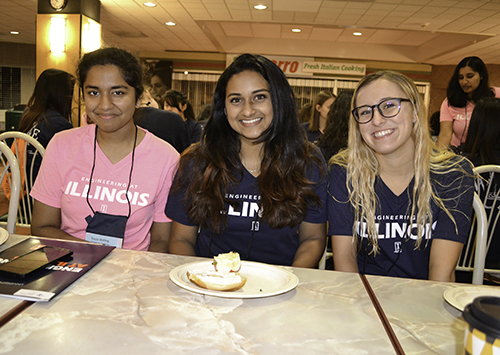
CS junior and WIE Orientation mentor, Pooja Welling, having breakfast in the Illini Union Basement with two of her mentees, CS freshmen Soumya Kuruvila and Mackenzie Kirkham.
Her roomie, Mackenzie Kirkham, is also in CS. How’d the two happen to room together? “We found each other on Facebook,” she admits. Kirkham participated in Orientation for pretty much the same reasons. “I don't know anybody, because I'm actually from out of state, too—from Indiana. So I don't know anyone on campus. I decided it would be a great way to meet other people, especially in engineering.”
Kirkham picked Illinois because of the CS program’s reputation, “and I really liked how it was different than other CS programs at other schools. It looked really strong,” she says.
And it wasn’t just freshmen who enjoyed Orientation. Pooja Welling, a CS junior who wanted to “pass it on,” acknowledges, “I did WIE Orientation when I was a freshman, and I made a lot of really close friends through it. Also, I'm still friends with my mentor from Orientation, and I wanted to do the same for other people.”
Her mentor, a year older than her, is still here in the CS program. “I ask her a lot of questions still, two years later,” Welling admits. Regarding the experience, she adds, “I think it's just really fun to be here. I love meeting freshmen.”
WIE Orientation PLanning Committee

Counterclockwise from the bottom left: Elizabeth Sanders, Amy Cain, Angie Wolters, Brooke Newell, and Siobhan Fox, the members of the 2017 WIE Orientation planning committee.
Members of the planning committee also share why they devoted so much time and energy to the event.
For example, Engineering senior and co-coordinator Elizabeth Sanders shares how Orientation impacted her as a freshman…and is still doing so to this day. She reports deciding to attend, “Because I was really worried about making friends, initially, and the whole college thing is very scary. So I thought it was a great opportunity to kind of get my feet wet a little bit early and come to college and learn all of these cool things.”
How is it still impacting her college career? “I actually met my now best friend and roommate for two years at WIE orientation…and I definitely thank WIE Orientation for that. I had met her at registration, and I recognized her face, and we both happened to come to WIE orientation, and we saw each other, and we're like ‘Oh, my gosh! A face that I know!’ It was really cool, because after WIE programming ended, each night we would go and watch movies, and that was definitely kind of the start of our friendship.”
As a mentor, Sanders hopes to help facilitate the freshmen’s friendships, “Because I gained my best friend, I want to make sure the girls have the same experience that I did. It's really cool to see that, and all the friendships form.”
She’s also enjoyed watching WIE orientation evolve. “It used to be a little different, but now I think it's really cool that we're on campus for the whole time, because the girls are going to be here on campus, so I think it allows a lot of opportunity for girls to get more exposure to the buildings and just become a little bit more familiar with campus. So that's one really cool thing that I've seen.”
She also has enjoyed being a co-student coordinator. “It's awesome to give back to the program in this way because, like I said, I had so much fun my freshman year.”
Co-Student Coordinator, Siobhan Fox, shares that prior to coming to college, she didn't really know what engineering was or what she could do with it. Only a handful of students from her high school had actually chosen engineering, or even STEM-related fields. Plus, engineering had never been emphasized in her family; she didn't have a relative or a parent in an engineering field. “So when I was coming to college,” she reports, “I was very intimidated by what this degree could hold. I knew that Illinois was a prestigious program; I knew that it was going to be a very rigorous curriculum that I went through, and I was pretty intimidated.”

Co-Student Coordinators Elizabeth Sanders and Siobhan Fox interact with the freshmen during the introductory session to WIE Orientation.
She recalls that on the first day of her freshman orientation, when the WIE Orientation team welcomed them, their words changed her attitude completely.
“I didn't know anyone in that room. I was the only girl from my high school to come study engineering at Illinois, and I didn't know who to talk to, but I just remember hearing the student program coordinators stand up there and seem very kind and approachable people. They just told us that, ‘You're here for a reason. You worked hard, and you got admitted to the College of Engineering. Even if you don't think that this is something you can succeed in, you are here for a reason, and you can absolutely accomplish what you want to here in your four years.’ And I remember being inspired by that, and I thought that maybe someday, I can be in the same position, and now I am. So hopefully I can tell all these incoming freshmen that they're here for a reason, and if they put their mind to it, they can succeed, too.”
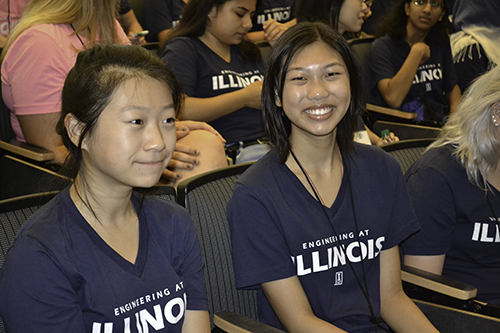
A couple of Illinois engineering freshmen wait for the introductory session of WIE Orientation to begin.
Participating in WIE Orientation was also significant for the other committee members. For instance, Brooke Newell shares, “I think because it does inspire incoming students, so that it does give them a community, a smaller place, because Illinois is so large—a place where hopefully they can find a home, a group of friends, their departments, just a place where they feel like they belong.”
Her first time participating, Newell had enjoyed watching the progression, from sending out letters inviting students to attend Illinois, to registration, to WIE Orientation. “It's a pretty neat experience…seeing it from freshmen registration right after we have sent letters out…meeting some of these students and how excited they were to register…to getting emails where they're super excited in replying. I think it’s come full circle. It's a great thing, the academic staff working with current students and these incoming students. I think that makes Illinois unique.”
Angie Wolters also loves the process—watching the students come as freshmen then leave four years later, confident engineers. “This is my favorite program of everything we do. Because each year it's so exciting to see the new class come in, have their future before them…whether they feel like they're fully prepared and able to do this or they're somewhat intimidated. At the end of these next four years, we see them evolve from these freshmen into amazing future leaders that are going out to change the world. So when we stand up there, and we look out at the freshmen class, it really is touching to see them then and see them evolve into the Elizabeth’s and Shibohan’s that are here to be our next coordinators.”
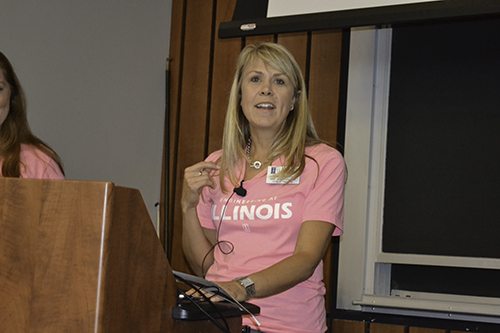 Angie Wolters, Women in Engineering Director, shares with the freshmen during the introductory session of WIE Orientation.
Angie Wolters, Women in Engineering Director, shares with the freshmen during the introductory session of WIE Orientation. Wolters touches on the long-term nature of the community and relationships built during Orientation, sharing an anecdote about one student who had come as a freshman. “She was a MatSE, and she met this core group of friends at WIE Orientation. And she just sent us pictures from her wedding, and she had the picture of them from freshmen year, all the MatSE girls together!”
Regarding the Women in Engineering Community that Orientation helps to build, Wolters mentions receiving numerous emails and texts in the weeks before Orientation, wishing the team luck. “It really makes me realize how wonderful the community we have and the friendships that they build, the friendships we build with them, the multiple layers. Here I have alums that were here as program coordinators who are sad that they're not here. But now we have ones like Molly Pace—these girls came as freshmen themselves and they're going to stand up in front of the girls and talk about this and talk about what they're doing now. It almost feels multi-generational; it shows how important this really is.”
Story and photos by Elizabeth Innes, Communications Specialist, I-STEM Education Initiative
More: Engineering, WIE, Women in STEM, 2017
For additional I-STEM articles about WIE Camp, see:
- Mariano & Pace Encourage Female Engineering Students: "You Too Can Succeed!"
- At WIE Orientation, Engineering Freshman Women Experience Campus, Build Community
- Cindy and Stephanie Richartz—Keeping It in the Illinois Engineering Family
- WIE Orientation 2015 Shows Female Engineering Freshmen the Ropes
- WIE Camp 2014: Creating Community for Female Engineering Students
- Women in Engineering Camp Facilitates Relationship Building
- From WIE Camp to Seniors: Two Future Engineers Credit Illinois' Community of Support
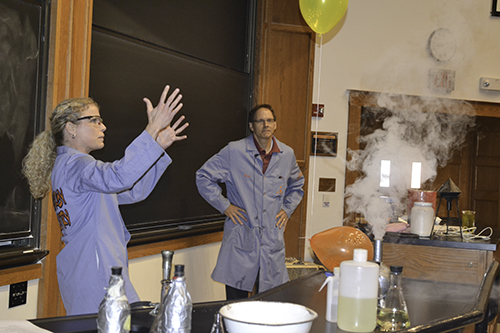
Gretchen Adams and Don DeCoste doing a chemistry demonstration.
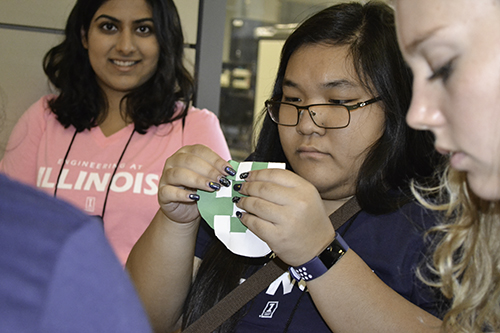
A freshman (center) does Larson's weaving exercise.
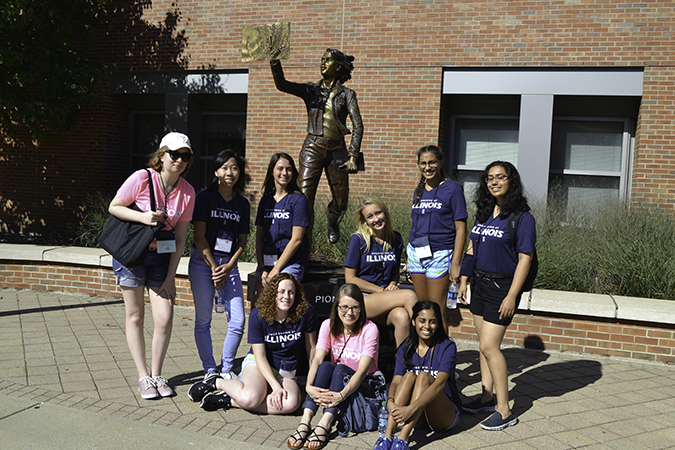
Engineering freshmen and their mentors (pink shirts) pose by the statue of the Quintessential Engineer.













.jpg)
















